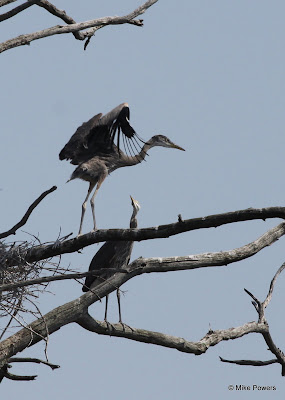Hint: click images for larger versions.
We knew it would happen one way or another: eventually, the Great Blue Heron nest would empty out. We all hoped for a successful fledging, but as anyone who observes the natural world knows it doesn't always turn out the way you wished. This was the first nesting attempt by Great Blues in Sapsucker Woods, so it's understandable there was a bit of trepidation underlying our excitement. We tracked the progress ever since the first stick was laid back in April, and now I'm happy to report a successful fledging. As of 9:00 AM this morning the nest was empty after the fourth bird took flight, the other three left ten minutes earlier.
This was to be an update post with some photos I took two days ago, but instead of marking progress the images serve as a reminder. Ah, the memories. Remember when the young were still in the nest? That was cool.
Or is it too early?

I suspect the new fledglings will stick around, if I find them on my walks I hope to capture instances of them learning to behave like adult herons. Remember that first meal you had to cook by yourself in your first apartment? They're going through the same thing, but likely without the visit from the fire department.
-







4 comments:
Thanks for the update! I was wondering when they would depart the nest.
@jan_m - Laura Erickson, the one who tracked the herons more closely than anyone else, calculated the young ones hatched 55 days ago. That means they left the nest 5 days earlier than the Birds of North America Online allowed us to predict: "sustained flights begin at 60 days."
Considering they successfully fledged four young, they had a pretty remarkable season!
-Mike
I've been monitoring a GBH rookery for my county this year. 17 nests & highest count for fledglings was 37. We were treated to first flights for several.
Am now suffering my own version of "empty nest syndrome" as "my birds" have dispersed.
@deejbrown - I'm wondering what the future of Sapsucker Woods holds: since the nesting was successful, will they return? With more? In a few years will we be a full-blown rookery?
It must have been exciting to track a rookery through the season, rather than the usual once-per-season viewing. Except for the "empty nest," of course!
-Mike
Post a Comment